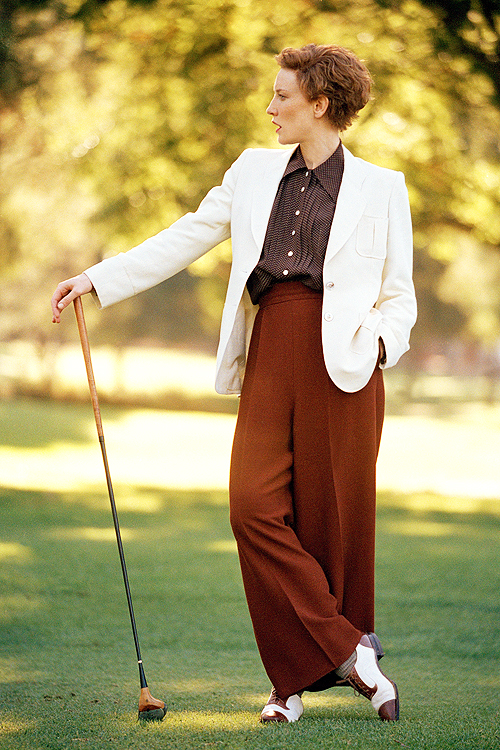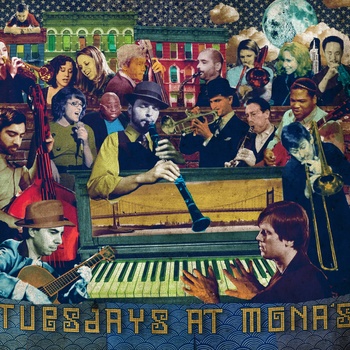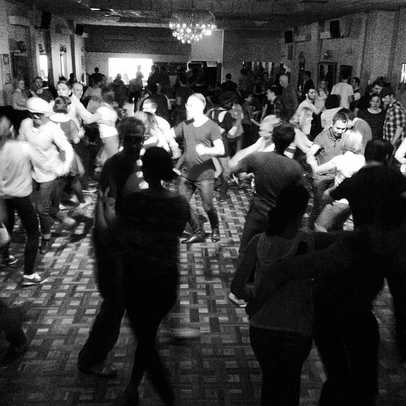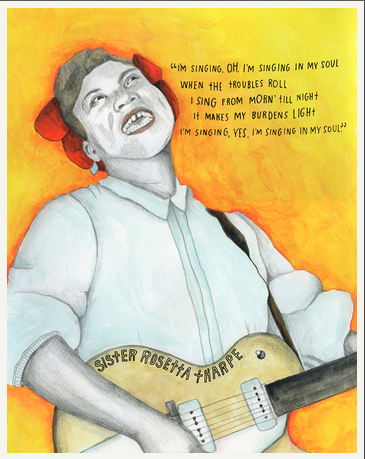Kate Blanchett in the Aviator, rocking Katherine Hepburn stylez.
Not the best film ever (oh, Leonardo, why did you grow up?), but the sound track is AMAZING.
Category Archives: music
Hot Four (thousand)
If you haven’t bought this yet, WHAT’S WRONG WITH YOU? But seriously, if you like jazz, then you should buy this live album. It’s just so fricking good. I’ve heard a couple of DJs complain that the songs are too long for DJing. To that, I say BAH!
‘Tuesdays at Mona’s’
Mona’s Hot Four
purchase directly on bandcamp
Personnel:
Mona’s Hot Four:
Dennis Lichtman – clarinet/session leader
Gordon Webster – piano
Nick Russo – banjo/guitar
Jared Engel – bass
Guests:
Emily Asher – trombone
Ehud Asherie – piano
Gordon Au – trumpet
Bob Curtis – clarinet
Mike Davis – trumpet
Jim Fryer – trombone
Miles Griffith – vocals (DVD only)
J. Walter Hawkes – trombone
Tamar Korn – vocals
David Langlois – washboard
Dan Levinson – clarinet
DAVID MCKAY – vocals
Nellie McKay – vocals (DVD only)
Andrew Nemr – tap dance
Jerron Paxton – vocals & banjo
Nathan Peck – bass
Molly Ryan – vocals
Bria Skonberg – trumpet
Dave Speranza – bass
Chris St. Hilaire – snare drum
Miss Tess – vocals
Murray Wall – bass (DVD only)
(musicians dancers probably know are in bold)
Treat your DJs good: get more chicks
I read some thing on vernacular jazz dance about the lack of female DJs at European swing dance events…which I now realise was a response to my joke post about women DJs, which was actually Olive and Astrid in Fringe, being science nerds.
This past MSF (which is one of the two biggest Australian events), we had these DJs:
(c/o KatGalang)
me (I’m a woman btw)
Kat Galang (woman)
Alice Roberts (woman)
Barb Heggan (woman)
Allie Payne (woman)
Manon van Pagee (woman)
Mike Healey
Trev Hutchison
Gas Fernandez
Keith Hsuan
Tim Jones
Matt Greenwood
That’s 50% wimminz, 50% menz.
I was the DJ coordinator. I don’t think about gender when I’m putting together DJ teams. I look for:
– mad skills (ie can work a room, keeping the floor full is just entry level requirement)
– professionalism (answer emails promptly, on time, have the right gear, get their shit together, on time, etc)
– personable and easy to work with (grumpy poos can get fucked)
– good music collection
– experienced (I don’t use new DJs for big events)
Any DJ who gives me shit is immediately blackballed – eg if they send me nasty emails because I didn’t hire them (yes, this happens about every second event); if they’re nasty to _anyone_, if they do something I asked them not to (eg play soul in a swing set, dance during their set, etc etc), if they miss sets or are late to sets, etc etc. This last set is the most important criteria for me. This job is kind of tiring and annoying, and I just don’t need some dick giving me shit at 2am on the third night of an exchange. If I’ve told you to play fucking swing, play fucking swing and shut that funk down.
I don’t think it’s an accident that I get good men:women ratios. Most of the local DJs in most local Australian scenes are women. But they rarely step up to national level events – they’re under-represented. I think that’s because they’re not confident about stepping up, and aren’t supported (I’ve written about this a LOT, so you may want to search for more posts on this if you’re looking for some rants).
Why do some Australian events have massively more male DJs than men? The events that have these imbalances almost always also have pretty shitful working conditions and pay deals for their DJs, and they almost always have pretty awful approaches to DJ recruitment/hiring. They just hire randomly. They hire DJs who approach _them_. Seriously, why would you do that? If you want good DJs, you chase THEM. Don’t give them a chance to approach you – woo them! This means that they get the pushy blokes on their roster. And they miss out on the less confident ninjas.
There are times when events have fewer women DJs than men and the organisers have done everything right. Some years and some events, this is just how things pan out. But if you don’t have a good female:male DJ ratio for your event year after year, _you’re_ doing something wrong.
Why should you chase DJs? Isn’t that more work? Yes. But fuck, do you want good DJs or do you want people who pimp themselves out aggressively? Also: don’t be a lazy arse. Get your shit in gear.
Once you get your DJs, treat ’em right.
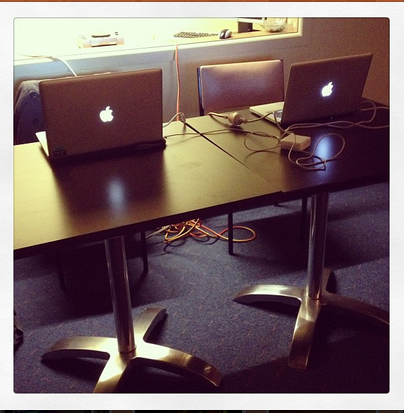
(c/o KatGalang)
I treat my DJs with respect. Even if I’m exhausted. Because YOLO, so you bloody well owe it to people to treat them right. And being nice to people makes you feel nice. WIN.
I pay DJs as much as I can, and I agitate for better pay ever year. btw the base line for a decent event is now: a free pass, plus at least $25 per hour. The best deal is a free pass + $30 per hour. I think this is total rubbish. DJs deliver the bulk of music at Australian events, yet is has the lowest value. WRONG TOWN. I don’t think we pay our DJs anywhere near enough, so I keep banging on to organisers about improving pay.
I’m also very strict about working conditions for DJs – safe, clean work spaces. Good notice on set times. If you’re booked for a set, I pay you for it, even if it’s cancelled. If you pay longer, you’re paid for that. Your name is plastered over the PR material. You get lots of public props. Prompt pay, in cash. Don’t harass your DJs. Make sure they’re not being harassed by the punters, and if they are, shut that shit down. If a DJ has a problem, YOU solve it – they just handball it up to you. BAM!
If I can’t manage these things (sometimes shit happens), I make sure I fix it as SOON as I can. And I apologise. I chase down DJs after events for feedback, and I assume that we can always improve things.
(c/o DJTrev)
I’m also always on the look out for new talent. Yes, I do favour experienced people, and because our national scene is so small, you’re going to see the same names on my lists. But that’s because they’re good. I don’t do nepotism. I do awesomism: if you’re awesome, I’ll hassle you until you DJ for me.
When I find new talent for big events, I only use them if they have experience with smaller events. They have to have been DJing for a few years, and dancing for longer. I have to have seen/heard them DJ before.
I try to give all the DJs I hire a lot of support – I deal with their problems, etc etc. And I try to make sure newer DJs have support too – maybe an experienced DJ buddy, or perhaps they need more time to set up before a set. Or maybe they need a bit of a pep talk. Or some quiet time. Whatever it is, I try to make it work. I think that if I want ninja DJs, I need to invest in ninja DJ development.
I also try to make sure the experienced people don’t get too burnt out. But that’s hard – we have too few DJs to work all our events. I also try to offer them interesting set briefs, and I encourage interesting set ideas.
So, basically, if you treat your DJs well, and get up off your arse and hunt down some peeps with mad skills, you’ll get good gender ratios in your DJ line up.
OMG JUST LIKE REAL LIFE
Fully fats
title – year – artist – bpm – length
You Hear Me Talkin’ To Ya – 2009 – Luke Winslow-King (Rich Levison, Cassidy Holden, Shaye Cohn) – 142 – 2:12
Truckin’ – 2012 – Paul Asaro And The Fat Babies (Andy Schumm, John Otto, Beau Sample, Jake Sanders, Alex Hall) – 189 – 4:27 – What a Heavenly Dream: The Fats Waller Rhythm Project
Shortnin’ Bread – 1941 – Fats Waller and His Rhythm (John Hamilton, Gene Sedric, Al Casey, Cedric Wallace, Slick Jones) – 195 – 2:41 – The Last Years (1940-1943) (disc 02)
The Girl I Left Behind Me – 1941 – Bob Wills – 206 – 2:40 – San Antonio Rose [disc 10]
Bearcat Shuffle – 1936 – Andy Kirk and his Twelve Clouds of Joy (Mary Lou Williams) – 160 – 3:01 – The Lady Who Swings the Band – Mary Lou Williams with Any Kirk and his Clouds of Joy
Peckin’ – 1937 – Johnny Hodges and his Orchestra (Cootie Williams, Barney Bigard, Otto Hardwick, Harry Carney, Duke Ellington, Fred Guy, Hayes Alvis, Sonny Greer, Buddy Clark) – 165 – 3:10 – The Duke’s Men: Small Groups Vol. 1 (Disc 2)
Fat And Greasy – 1935 – Fats Waller and his Rhythm (Herman Autrey, C.E. Smith, Eddie Anderson, Fred Robinson, George Wilson, Rudy Powell, Gene Sedric, George James, Emmett Matthews, Fred Skerritt, Hank Duncan, James Smith, Charles Turner) – 162 – 3:11 – I’m Gonna Sit Right Down: The Early Years, Part 2 (disc 02)
Here Comes Your Pappy (With The Wrong Kind Of Load) – 1936 – Putney Dandridge – 177 – 2:37 – Complete Recordings Putney Dandridge 1935 – 1936
Stomp It Out Gate – 1938 – Rosetta Howard acc. by Harlem Hamfats (Herb Morand, Odell Rand, Horace Malcolm, Joe McCoy, Charlie McCoy, John Lindsay, Fred Flynn) – 142 – 3:06 – Harlem Hamfats Vol. 4 1938-1939
Give Me Some Skin – 1941 – Lionel Hampton and his Sextette (Karl George, Marshal Royal, Sir Charles Thompson, Ray Perry, Irving Ashby, Vernon Alley, Shadow Wilson, Ruble Blakey) – 138 – 3:16 – The Complete Lionel Hampton Victor Sessions 1937-1941 (Mosaic disc 05)
Sent For You Yesterday – Benny Goodman – 158 – 3:04 – China Boy
St. Louis Blues – 1939 – Ella Fitzgerald and her Famous Orchestra – 183 – 4:46 – Ella Fitzgerald In The GrooveJive At Five – 2013 – Mint Julep Jazz Band – 171 – 3:23 Durham On Saturday Night
Splanky – 1966 – Count Basie and his Orchestra – 157 – 3:52 – Live at the Sands
B-Sharp Boston – 1949 – Duke Ellington and his Orchestra – 126 – 2:55 – Duke Ellington and his Orchestra: 1949-1950
No Regrets – 1936 – Billie Holiday and her Orchestra (Bunny Berigan, Artie Shaw, Cozy Cole) – 130 – 2:38 – Lady Day: The Complete Billie Holiday On Columbia (1933-1944) (Disc 01)
Sugar – 1946 – Louis Armstrong and his Hot Seven (Vic Dickenson, Barney Bigard, Charlie Beale, Leonard Feather, Allan REuss, Red Callender, Zutty Singleton) – 138 – 3:26 – The Complete RCA Victor Recordings (disc 03)
Laff, Slam, Laff – 1945 – Slam Stewart Quartet (Erroll Garner, Mike Bryan, Harold ‘Doc’ West) – 156 – 2:59 – Bowin’ Singin’ Slam
Stompin’ At The Savoy – 1944 – Teddy Wilson Sextet (Emmett Berry, Benny Morton, Edmond Hall, Slam Stewart, Big Sid Catlett) – 182 – 3:52 – Teddy Wilson: The Complete Associated Transcriptions 1944Chasing Shadows – 1935 – Louis Prima, Pee Wee Russell, Frank Pinero, Garry McAdams, Jack Ryan, Sam Weiss – 170 – 3:04 – Louis Prima Volume 1
The Spinach Song – 2004 – Terra Hazelton (feat. Jeff Healey’s Jazz Wizards) – 165 – 4:57 – Anybody’s BabyMe, I Get High on Reefer – 2010 – The Two Man Gentlemen Band – 200 – 2:17 – ¡Dos Amigos, Una Fiesta!
Shave ’em Dry – 1997 – Asylum Street Spankers – 131 – 4:21 – Nasty Novelties
This is the set I did on Sunday night at the late night dance during MSF. It was a cracking night. The workshops had been fun, and people finally felt they could stay up late and dance like fools. The evening dance had been a crowded event (1600 people bought tickets!) and there hadn’t been too many opportunities for dancing. So the late night was where it was at.
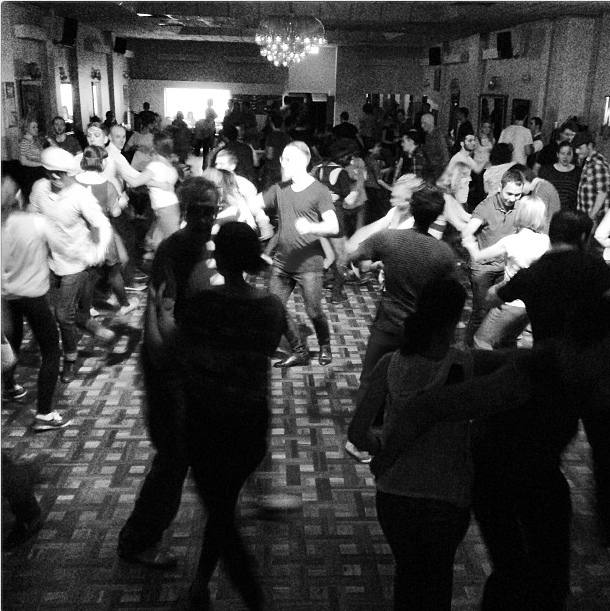
(photo c/o Trev
This was a challenging set for me. I was at the back of the room, at floor level, in a loooong narrow room. In that photo of Trev’s above, you can _just_ see the DJ, right at the back, silhouetted against that bright square. That’s either me or Kat DJing at a table [EDIT: Kat says that Trev says that that’s her DJing, not me. So I’d have been DANCING! SCORE!]
I could see perhaps 20 people of the 200 in the room. And those 20 were at the ‘back’ of the room – the newer dancers. I’m used to playing with the show offs and more experienced dancers right in front of me. During those sets, I have to keep reminding myself to watch the _whole_ floor, not just those peeps. But on Sunday I had to keep standing on a chair so I could see even perhaps just a few body parts of that same crowd.
I was following Kat Galang, who is relentless. She comes in hard and fast, pounds the dancers, then goes out with a bang. She makes people CRAZY with adrenaline. Fucking best dancing fun. Can be a challenge following, as a DJ, as she leaves the dancers utterly shagged. And I’ve found that if I chill it out too much (to give dancers a rest), they just sit down, realise how shagged they are, then pass out. So I have to keep things a bit sprightly so I don’t lose them. But if I pounded it the way she did, they’d probably die of heart attacks. So the goal is good energy, working shorter waves with lots of resting points, but keeping things exciting and interesting.
Here is what I noticed:
Because I couldn’t really see anyone’s bodies or faces, I couldn’t read the crowd. I couldn’t even really tell if the floor was empty or full, because I couldn’t SEE it. So I had to go with my instincts and… well, I guess I was going by my nose, and making sure I walked the room a lot.
I definitely benefitted from that particular time slot – peeps were ready to rock out.
Righto, what did I play?
First off, I love that Luke Winslow King song. Galang had played quite a few good NOLA tracks, by modern bands, and LWK is a NOLA boy, Cassidy Holden does lots of NOLA bands. So that echoed her work. It’s a moderate tempo, but it sprongs along with that gorgeous steel string guitar giving a nice western swing edge. The trinkly piano reminded everyone that this was still NOLA. Sort of. Best song. Only bad thing about it is that it’s TOO SHORT.
Fats Waller is in my brain a lot atm as we teach with him a fair bit, and I’ve found he’s really, really interesting for good solo dance work. So I wanted to DJ him a lot. He’s so light and funny, but he’s also so technically stunning, and the arrangements are rippingly good – really perfect for the complexities allowed by solo dance.
So I played that Fat Babies version of ‘Truckin”, to segue from the LWK, and to get to more Fats.
Then I played my favourite Fats Song, ‘Shortnin’ Bread’. I was being a smartarse playing Fats after a Fats ‘cover’. Shortnin’ Bread is FABULOUS.
I was still thinking about LWK and western swing, and I wanted to get the energy back up to Kat levels, so I played that great Bob Wills song. I love Bob Wills. LOVE HIM. That song is fuck-off great.
Then I chilled it out a bit with some Andy Kirk. This is a song everyone knows (well, the old sticks do), so it’s nice and comfortable. I teach with a lot, and think of it as a mellow, friendly song. Still nice and right in the middle of my favourite style.
More chillaxin’, with ‘Peckin”. But this version builds and gets pretty wiggedy wacked in the middle, so it’s a good way to get to other stuff. It’s always fun to dance to, and again, it’s familiar. So these two were ‘safe’ songs for the dancers. I was also watching Skye working the room, and I wanted to make sure there were some more relaxed songs for the newer dancers to pounce on him for. I really liked that Skye worked the back part of the room, too, rather than just sticking with the ‘cool’ kids. That was nice.
More Fats. Current favourite teaching song. This one is fucking great for the Al and Leon shim sham. It sounds like Leon James’ dancing.
The beat (the guitar/drums) gets a bit more uppy-downy, bouncy-stompy, which is what I wanted to set up for the next song. The vocal style is also something I wanted to set up for the next song. Also, this song is THE BEST.
Putney Dandridge. I haven’t been able to chase down the specs for this song, but the band sounds so much like the group who did stuff 2nd March 1936 – Putney Dandridge and his Orchestra (Richard Clarke, Johnny Russell, Teddy Wilson, Arnold Adams, Ernest Hill, Cozy Cole) – that I think it might be them. And look at that band. Yes PLEASE.
This song fucking rocks. Dandridge’s vocals are best. BEST. I love the way he brings that sprongy, bouncy-stompy rhythm to the song. Loveity love love.
But peeps needed a bit of a rest, so I went to this nice Hamfats song. Mike Faltesek played this once in Melbourne and every time I play it now, people rush up to ask what it is. It’s great. Nice, slower tempo, but with a good, stampy rhythm. Nothing too complex, but great, great dancing.
I was beginning to think I needed to change the styles up a bit at this point. It felt like I’d done enough of that particular style, and I needed to get a bit more solidly classic swing, or to head towards the 1940s. Lionel Hampton feels like good, solid top-40 style lindy hopping swing to me. And I love this song at the moment. I like the lyrics (“You know much about ‘lectricity? I know ’nuff to leave it alone!”). It’s a great, medium tempo dancing song. Great, catchy melody. Yes.
This stuff reminds me of Count Basie. And ‘Sent for you yesterday’ reminds me of Basie (of course). So I played the Goodman version, because it’s unexpected. It has what I think of as a ‘building’ vibe – I play it when I want to set things up for a performance, or to build the room back up to high energy stuff.
So from there I went straight to the Savoy with Ella and Chick’s band. This one is a bit overplayed these days, and I was going to play something else like ‘Everybody Rock’ from those concerts, but I thought “Heck, I’m doing ‘top-40 lindy hop classic swing. So _do_ that.”
I was still thinking about Basie. But I wanted to chill people out a bit (they were really kind of shagged at this point). I do like this Mint Julep Band, and this version of ‘Jive at Five’ isn’t as smooth and groovy as the 1950s Basie versions, but the band has a guitarist I really like, and I wanted a hi-fi vibe to set up for the next song. So I played this version rather than the Basie 1939 one.
At this point Trev had come over to chat for a couple of songs (he was looking a bit pale, actually, and I was a bit worried that he might _really_ need a sit down – he’d been dancing like a fool for ages). I said “I need something really classic Basie… you know, like Easy Does It.” And then we both thought of the Live at the Sands version of Splanky at the same time. That nice in-the-pocket Basie sound, but with a bit of punchy energy, as the band responded the more modern music around them.
WIN!
I always think of the Big 18’s Easy Does It, Splanky, and this lovely Ellington song in the same group. B-Sharp Boston is tops. Ellington’s band did some great lindy hopping music in 1949 – really solid, classic swing. Just before they started doing some really wiggedy wacked stuff. And this is what I wanted. Solid swing, easy tempo, nice, clear melody. But if you listen carefully, the drummer is actually doing some really interesting things with brushes (?) and shuffley stuff, which quietly intimates what’s to come for the band.
Thinking about later Ellington going nuts, I was reminded of Billie Holiday, of course. She was doing such radical things with timing, and she really was super important. I find dancers often puzzle a bit over Holiday’s timing, but this crowd was totally ok with such relatively minor challenges. And I was thinking ahead to the Slam Gaillard song I wanted to play, which really does do wiggedy things with timing.
I love matching the Louis Armstrong version of Sugar with that Billie Holiday song. Because I associate Sugar with Holiday. I love the song. And this recording is interesting, for the name (the Hot Seven in 1946?) – it’s part of a lovely lump of 1940s Armstrong stuff which really rocks. And when you put Holiday and Armstrong next to each other like this, you really understand how they were both revolutionary in their approach to _swing_. True genius. Armstrong’s trumpet and Holiday’s vocals – it’s the same thing. And of course, in the back of my mind, Lester Young is connecting Holiday and Basie.
Finally we get to Slam. This song is teh sheeet. I love dancing to it on my own. It’s complicated. It’s interesting. It has a good, solid beat. Until that beat gets screwed with a bit. Again, the band is edging towards modernism. It’s only 1945, but you can hear Errol Garner beginning to think about the future; the space between the beats that swing requires, is getting stretched a bit, and kind of pulled in different directions.
Teddy Wilson. Oh, I love you. And with Slam Stewart in the band. Just the year before. This is good, tight chamber jazz. A little group of big talents, doing a very solid, safe swing classic. But they make it tight and interesting. Unlike Benny Goodman, it feels like there’s a bit more maneouverability here. The band feels like they’re allowed to be a bit softer. Less a super group like Goodman’s small group, more a super good group doing something really nice. This is one of my favourite shim sham songs. In fact, this is my favourite sort of music. Complex, tight, yet super swinging.
Right. Change it up! Less cerebral, more stomping. I love early Louis Prima, and I love this song because there’s a Putney Dandridge version that’s more widely played (Fatima played it at Hullabaloo! It was the only song in her set that I had a copy of and knew well. Sheesh. She’s a gun). This uptempo version isn’t quite as tight as it could be, but it has a lot of energy and fun. I do like the Chicago boybands (LOVE the Mound City Blue Blowers), but this one isn’t as esoteric as some of the MCBB, so it’s a bit more accessible.
Then I changed gear without the clutch. It felt like I’d been to fancy and complex. Time to just pull out the pub jazz (thanks for that line, Georgia). Shouting, stomping arse kicker chick music. Made the dancers crazy.
Then I extended the innuendo/euphemism theme with this great song about another type of green. I played this song mostly so I could see Trev mime smoking reefer and then trucking. I was not disappointed.
Loling at Trev, I lined up the next song and he yelled ‘you should play Shave em Dry next’, but he was joking. I wasn’t joking.
Shave em Dry is a good one, because it was overplayed to DEATH in about 2006, mostly for blues dancers. There were quite a few groans from the experienced dancers, and Trev shook his head in disappointment. I admit it: this was a cheap play for laughs. But at the same time, I was taking the piss. And yet not – what’s not to love about a woman singing about being big and fat and loving to fuck real good?
I play it a lot at the Roxbury at home, matching it with the Two Man Gentlemen Band and other shouty rude bands. I think that this stuff really embodies the Sydney lindy hop/rockabilly/rock n roll crossover community. The fight and fuck-off-fun attitude of rockabilly matched up with some spanking rhythm and musicianship of lindy hop.
Then I handed it all over to Keith, who made us dance like fools.
….You know, reading this back, I realise that all this explanation of what I was doing is in retrospect. When I’m actually DJing, I’m just going with what feels nice. I’m just making shit up on the fly.
I do think that you need to have a good idea of how to work a room, and how to balance tempos and things so you don’t kill people, but really, you’re working on the fly. I think that if I didn’t have so much experience working this particular event, I’d have struggled mightily without being able to see the dance floor. That was horrible. And I’m also pretty sure I would have done a better job working the room if I’d been able to see. But I think that the compromise was that I did a better job combining songs and working my collection, playing a wider, more interesting and less familiar set of combinations.
edit: reading this again, later on (now I’m home in Sydney again), I’m struck by how important my interaction with other DJs was that night. Kat, me and Keith were the DJs for that gig. Here are two of them:
 (photo c/o Kat)
(photo c/o Kat)
One of the things I love about big exchanges, is getting to work with and spend time with other DJs. People like Trev and Keith and Kat and Alice and… all those other great doods. I’ve learnt so much from sitting in on their sets (ie just sitting next to them, listening to them think their way through a set or respond to what they see on the floor). In fact, the most interesting sit-in I’ve done has been with a blues DJ, Manon, who is such a clever, observant DJ. I just don’t understand blues DJing, so Manon’s observations are so interesting.
I love sharing ideas about dancing and music, and I love the sorts of DJ in-jokes that get around. Rickrolling someone with C-Jam Blues, just as they step onto the dance floor with a famuss dancer. Playing their favourite song in the set before they’re DJing. Pulling out yet _another_ Fats Waller track, because all the other kids are doing it. I just find it all so inspiring and interesting. And I love hearing their latest loves – the songs they’re really into at the moment and just busting to play.
It’s where I get the best ideas for DJing and my own new music. I mean, Kat has THE best version of ‘For Dancers Only’ by Bob Crosby’s band – I can never remember to hunt it down myself, and every time she plays it, by last third I’m running at her to gush. And I play that Jimmie Noone 1930s songs ‘Blues Galore’ because Trev played it at MLX in about… 2006?… and I just love it. And Keith and I, because we also run events together, are always scheming a good scheme, coming up with a ridiculous plan for some sort of DJ-centred event. The climax of which was us two doing a ‘DJ jam’ set together one night, where we shared a plate of home-made-hommus-and-veggies while we pounded a couple of hours of music together, swapping songs back and forth.
#TeamSuperDJFriends. I’ve got the feels for you.
Shouting 8 track
name artist bpm length album year
Intro / Time’s Gettin’ Tougher Than Tough – Jimmy Witherspoon with Roy Eldridge, Ben Webster, Coleman Hawkins, Woody Herman, Earl Hines, Vernon Alley, Mel Lewis – 134 – 3:35 – The ‘Spoon Concerts – 1959
Splanky Count Basie and his Orchestra – 120 – 4:15 – Breakfast Dance And Barbecue – 1959
Roll ‘Em Pete – Big Joe Turner, Joe Newman, Lawrence Brown, Pete Brown, Frank Wess, Pete Johnson, Freddie Green, Walter Page, Cliff Leeman – 186 – 3:45 – The Boss Of The Blues – 1956
Wee Baby Blues – Count Basie and his Orchestra (Mahalia Jackson) – 64 – 3:14 – Live In Antibes 1968 – 1968
Cherry Red – Big Joe Turner, Joe Newman, Lawrence Brown, Pete Brown, Frank Wess, Pete Johnson, Freddie Green, Walter Page, Cliff Leeman – 96 – 3:25 The Boss Of The Blues – 1956
Every Day I Have The Blues – Count Basie and his Orchestra (Joe Williams) – 116 – 3:49 – Breakfast Dance And Barbecue – 1959
St. Louis Blues Big Joe Turner, Jimmy Nottingham, Lawrence Brown, Pete Brown, Seldon Powell, Pete Johnson, Freddie Green, Walter Page, Cliff Leeman – 154 – 4:20 – The Boss Of The Blues – 1956
Big Fine Girl – Jimmy Witherspoon with Roy Eldridge, Ben Webster, Coleman Hawkins, Woody Herman, Earl Hines, Vernon Alley, Mel Lewis – 156 – 4:55 – The ‘Spoon Concerts – 1959
Stormy Monday Blues – Count Basie and his Orchestra (Mahalia Jackson) – 121 – 3:50 – Live In Antibes 1968 – 1968
Joshua Fit The Battle Of Jericho – Mahalia Jackson – 130 – 2:13 – Live At Newport 1958 – 1958
Someone told me…
…Skye read(s) my blog and I felt like this
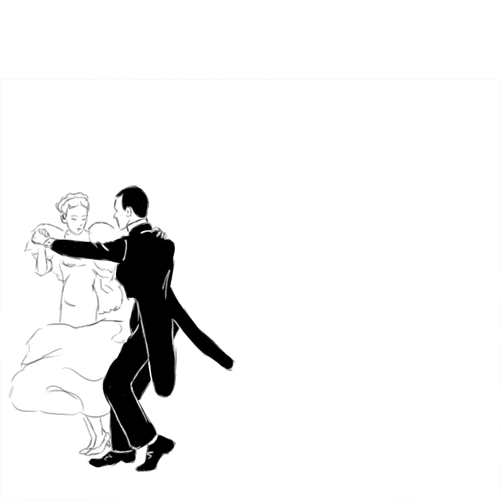
only with more squeeing in my pants*.
(image c/o carrionlaughing)
On a completely different tack, but still here in this post because yolo, bro, yolo…I play quite a lot of Big Joe Turner and Count Basie when I’m DJing. That’s like saying “I do a lot of Frankie moves when I lindy hop”, as though there was any other way of doing it. But there’s something about Turner shouting his guts out over some stamping fucking piano. That shit gets me hot. Hot in the ‘dances like a fool til she dehydrates’ way. The only way that really means anything, right?
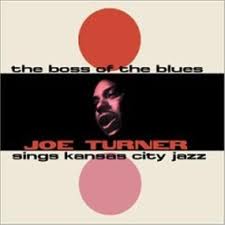
‘Boss of the Blues’ is not a pretentious album. It’s not particularly sophisticated. It’s not rare, it’s not unusual. It’s not delicate, not by any stretch of the imagination. It’s loud, it’s shouty. Sometimes Turner shouts so loudly into the microphone the sound distorts. And while he’s shouting that loudly, the brass section is blowing their guts out and it’s just all noise. The sort of noise that gets into your guts and makes you feel extremely strong, inarticulate feelings. This is party music. Loud, shouting party music. And slow, night time party music where you’re pretty sure you’re gonna get a really good fuck by the end of it. **
This is the sort of album that beckons in rock n roll with a stamping, shouting jump blues rhythm. It’s not some shitty modern day neo band. It’s a bunch of dirty old musicians playing dirty old music in a way that lets us know that things are changing, and yet still exactly the same.
This is not the sort of album that will impress your old scratchy DJ nerd friends, or score you any snobby pants old school dancer points. But it’s an album every lindy hopper, every blues dancer, every swing DJ, every blues DJ should have.
If I’m playing a song from ‘Boss Of The Blues’ (which I do most sets), set up by a bit of new testament Basie, I like to follow up with something from the The Spoon Concerts:
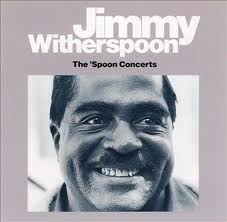
Why yes, I do like a dirty old man shouting about big legged women and money and being hard done by.
And if I still haven’t gotten it out of my system, I add something from this:
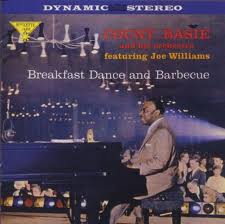
Because ‘Breakfast Dance and Barbecue’ was one of (if not the) first album I bought specifically for DJing for dancers. It’s all live, it’s all recorded late at night, everyone is trashed, but everyone is truly great.
I feel that the 1950s were a truly great era for good, solid lindy hopping music. The technology had finally gotten good, musicians weren’t being lynched in the street, bop and rock and roll were pushing jazz about in the playground, forcing it to get its shit together. People like Big Joe Turner, Jimmy Witherspoon, Count Basie pushed back.
*If there’s one thing I’ve never pretended to be, it’s cool, calm and sophisticated.
**Listen to that version of ‘Cherry Red’ and tell me you don’t agree.
[edit: soundtrack for this post here]
Jazz that nobody asked for
Oscar Peterson, Clark Terry, etc: ‘Mumbles’ live
The best part of this clip is where they just bow, pack their shit up and get off the stage. BAM. Dishes are DONE, dood.
Slim Gaillard, Bam Brown, Scatman Crothers
The Reconstructionists
This is such a fabulous project. Lisa Congdon and Maria Popova are creating the Reconstructionists:
The Reconstructionists, a collaboration between illustrator Lisa Congdon and writer Maria Popova, is a yearlong celebration of remarkable women — beloved artists, writers, and scientists, as well as notable unsung heroes — who have changed the way we define ourselves as a culture and live our lives as individuals of any gender.
Every Monday in 2013, we’ll be publishing an illustrated portrait of one such trailblazing woman, along with a hand-lettered quote that captures her spirit and a short micro-essay about her life and legacy.
The project borrows its title from Anaïs Nin, one of the 52 female icons, who wrote of “woman’s role in the reconstruction of the world” in a poetic 1944 diary entry — a sentiment that encapsulates the heart of what this undertaking is about: women who have reconstructed, in ways big and small, famous and infamous, timeless and timely, our understanding of ourselves, the world, and our place in it.
Here is one entry that seems especially appropriate for this blog:
When 23-year-old Sister Rosetta Tharpe (March 20, 1915 – October 9, 1973) first walked into the recording studio in 1938, she likely didn’t dare imagine that she would one day be celebrated as gospel music’s first superstar. The godmother of rock and roll. “The original soul sister.” But that’s precisely what the talented singer and electric guitarist went on to become, bridging the spiritual lyricism of gospel with the secular allure of rock and roll arrangements.

